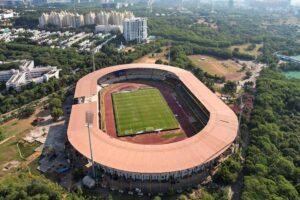July 29 has been recommended as ‘India’s National Football Day’ by Kanishka Pandey, head- Sports Research Centre at IMT Ghaziabad.
Published Date – 04:44 PM, Wed – 30 August 23

July 29 has been recommended as ‘India’s National Football Day’ by Kanishka Pandey, head- Sports Research Centre at IMT Ghaziabad.
New Delhi: July 29 has been recommended as ‘India’s National Football Day’ by Kanishka Pandey, head- Sports Research Centre at IMT Ghaziabad.
July 29, 1911, a red-letter day in Indian history. The Swadeshi Movement had died out with top leaders mostly arrested, retired or in their heavenly abode. The Revolutionary Movement was gaining strides. The general population was mainly a spectator with mostly mundane activities hither thither.
It seemed as if the country needed a spark. And the spark came not in some political rally or through an act or martyrdom but it was from a football field. Mohun Bagan, one of the oldest football clubs in Asia founded in the year 1889 in Kolkata by three prominent aristocratic Bengali Families achieved the impossible within a span of 22 years.
On July 29, 1911, it became the first Indian Club to lift the IFA Shield defeating the East Yorkshire Regiment 2-1.
The paragraph is a small excerpt from a letter given to the All India Football Federation (AIFF) by the Sports Research Centre team of Institute of Management Technology Ghaziabad. It’s worth mentioning that last month, AIFF partnered with IMT Ghaziabad to empower Indian Football Through Research and Innovation. Month and a half down the line, IMT Sports Research Centre has submitted its first recommendation in the form of declaring the date 29th July as the National Football Day of India.
Kanishka Pandey said, “This victory of Mohun Bagan over East Yorkshire Regiment in the finals, was not just a victory of 11 players, or the victory of a club or of Bengal. It was the triumph of a nation over their masters. India’s freedom struggle was not just about moderates, extremists, revolutionaries, it was also about these victories which we achieved in different areas. Battles were not always fought in battlegrounds and courts.”
“There were times when they were on the sports field. Though there is no denying the fact that these victories were not always capitalised, but at the same time, there is no denying the fact they acted as huge confidence boosters for the Indian population.”
Speaking further of the impact of this victory on Indian population, Dr Pandey further said, “This victory should be seen from five different perspectives- Confidence to Indians that if they can defeat the British in playground then same can be done outside it, Burst the myth of physical inferiority- when 11 feeble barefooted Indians defeated 11 booted strong Britishers in a manly sport like football, Gave a fillip to unity and nationalism and all sections came together to celebrate this victory, might have been one of a reason for the British to move their capital from Calcutta to Delhi as the victory was being celebrated very aggressively by the population which was humiliating for the British and of course it boosted the Indian footballing culture.”




